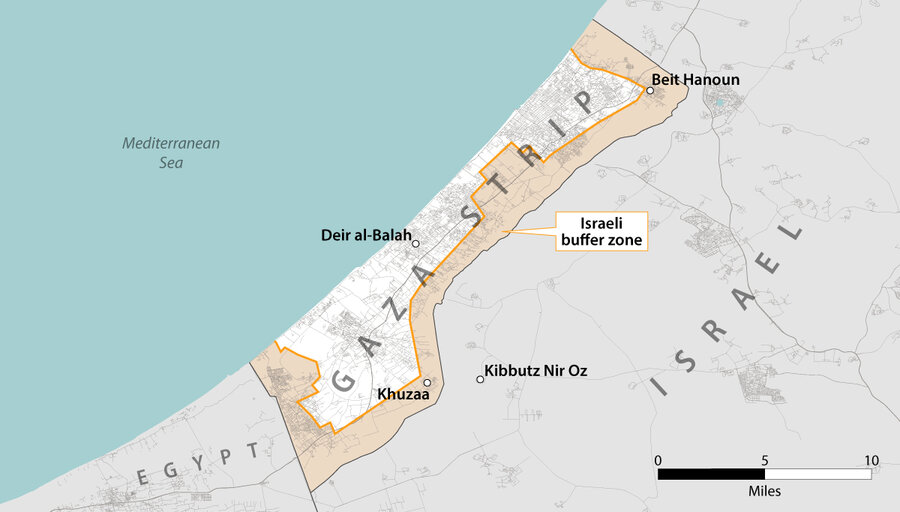Mohammad Abu Mitleq no longer dares step foot on his farmland.
The greenhouses he built by hand, the rows of 120 apricot trees, 300 peach trees, and 70 olive trees he tended on soil his family has farmed for generations – all lie inside a zone that could mean instant death upon entering.
“If I try to reach it, I’ll be sniped, bombed, or both,” he says. “That land is no longer accessible. Not to me, not to anyone.”
Why We Wrote This
Throughout the war in Gaza, Israeli buffer zones have steadily expanded through a series of evacuation orders. While the orders are often framed as security precautions, for many Palestinians they appear to be part of a slow-motion land grab.
The father of 11 chose farming in the Gaza Strip border town of Khuzaa, in southeast Khan Yunis, carrying on the family profession on the 8.4 acres of fruit and olive groves he inherited from his father.
Today, that land sits in what Israel has declared an expanded buffer zone on the Gaza-Israel border, directly opposite Kibbutz Nir Oz, the Israeli farming community worst-hit by Hamas’ Oct. 7, 2023, attack.
The Israeli military has declared Khuzaa, like many areas in Gaza, to be a “dangerous combat zone,” preventing residents from returning home. Throughout the Israel-Hamas war, zones such as these have been methodically expanded through a series of evacuation orders.
In this way, Israel has now restricted Palestinians’ access to 85% of Gaza, according to the United Nations Office for the Coordination of Humanitarian Affairs (OCHA). While the displacement orders and designation of zones as off-limits are often framed by Israeli authorities as security precautions, for many Palestinians they appear to be part of a more deliberate, slow-motion land grab.
It is dispossessing Palestinians of both their homes and their livelihoods.
“They want to swallow our land, meter by meter,” Mr. Abu Mitleq says. “It’s not just my field they’ve taken. It’s our future.”
Aerial imagery shared by Israeli media shows scorched fields, bulldozed orchards, and flattened homes across Khuzaa. Local residents confirm the destruction. “The apricot trees are gone. Livestock pens, empty. It’s as if everything I built over decades was erased overnight,” Mr. Abu Mitleq says.
Najah Qudeih used to live a life deeply rooted in Khuzaa.
“I remember walking to the fields with my mother, grandmother, brothers, and sisters,” says Ms. Qudeih.
On land inherited from her family, she and her husband used to cultivate rows of olives, oranges, lemons, and other citrus trees, filled in between with onions, garlic, and parsley.
“We used to grow enough to feed ourselves, our neighbors, and even sell a little,” she says.
Ms. Qudeih raised nine children – six sons and three daughters – on that land. She also kept doves, rabbits, and chickens. “We lived a typical peasant life,” she says. “Simple, but full of pride.”
Ms. Qudeih and her husband were preparing for the olive harvest when Hamas launched its attack on Israel.
Ms. Qudeih’s son Suhaib had risked his life to sneak back into Khuzaa to plant tomatoes and check on the land. Now, he cannot even attempt a return due to ongoing Israeli military operations.
“We were the first to be displaced; the first to be abused,” says Mr. Abu Mitleq. “No one knows if we’ll be able to return to our homes.”
Hanan al-Kafarna last saw her half-acre of land in Beit Hanoun, in northern Gaza, on Oct. 6, 2023.
Since then, she hasn’t heard any news about it – or even caught a glimpse on social media. During the nearly two-month ceasefire this year, neither she nor her nine children could approach the land. It lay out of reach, off-limits, in the Israeli buffer zone.
Before the war, Ms. Kafarna and her husband worked their small plot of land themselves. “We fed ourselves from that soil,” she says, seated on a plastic mat inside a displacement camp in Gaza City. “Guava, lemon, melons, eggplant – whatever the season gave us, we used it. We ate from it and sold the rest to neighbors. It wasn’t much, but it was ours.”
Now, that life is gone. So, too, is their ability to feed their family.
“We had chickens, goats. The land kept us alive, even in the hardest years. We never had much money, but we never went hungry.”
“We had offers in the past – people wanted to buy the land. We always refused. I told my children: ‘You do not sell the land. Ever.’”
One of her sons tried to reach it during the ceasefire, risking his life to see if anything was left. He came back empty-handed. “He said it’s a red zone,” Ms. Kafarna says. “The army doesn’t let anyone near it.”
Even as Ms. Qudeih’s family contemplates leaving Gaza, she resists.
“I refused. Khuzaa is in my soul. The air is clean, the people are connected. We knew our neighbors. Our aunts, uncles, our children — we were all close. Now we are scattered. Dispersed.”
Aerial photos from the area shared by Israeli news sites show Khuzaa as a ghost town.
“Back then, we lived,” she says of the time before the war. “Now, we just survive.”













